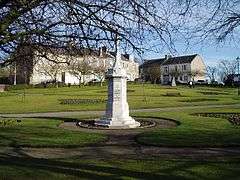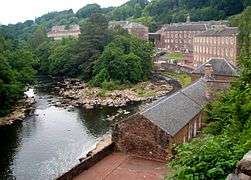Lanarkshire
Lanarkshire, also called the County of Lanark (Scottish Gaelic: Siorrachd Lannraig, Scots: Lanrikshire), was an historic county in the central Lowlands of Scotland.
Lanarkshire | |
|---|---|
 Rolling Lanarkshire countryside near Lanark Town | |
 | |
| Country | Scotland |
| County town | Lanark (historic) Hamilton (modern) |
| Area | |
| • Total | 879 sq mi (2,277 km2) |
| Ranked 11th of 34 | |
| Chapman code | LKS |
Historically, Lanarkshire was the most populous county in Scotland, containing as it did most of Glasgow and the surrounding conurbation.
In earlier times it had considerably greater boundaries, including neighbouring Renfrewshire until 1402.[1] Lanarkshire was bounded to the north by the historical counties of Stirlingshire and Dunbartonshire (this boundary is split into two sections owing to Dunbartonshire's Cumbernauld exclave), to the northeast by West Lothian and Mid Lothian, to the east by Peeblesshire, to the south by Dumfriesshire, and to the west by Ayrshire and Renfrewshire.[2]
Administrative history
Lanarkshire was historically divided between two administrative areas. In the mid-18th century it was divided again into three wards: the upper, middle and lower wards with their administrative centres at Lanark, Hamilton and Glasgow, respectively, and remained this way until the Local Government Act of 1889. Other significant settlements include Coatbridge, East Kilbride, Motherwell, Airdrie, Blantyre, Cambuslang, Rutherglen, Wishaw, Bellshill and Carluke.[3]
In 1975, the county council was abolished and the area absorbed into the larger Strathclyde region, which itself was abolished when new council areas for Scotland were introduced in 1996. The old area of Lanarkshire is now occupied by the council areas of:
- East Dunbartonshire (1996–present)
- Glasgow City Council (1996–present)
- North Lanarkshire (1996–present)
- South Lanarkshire (1996–present)
North Lanarkshire and South Lanarkshire have a joint board for valuation and electoral registration. There is also a joint health board, which does not cover Rutherglen and the surrounding area in South Lanarkshire. Without the northern portion of North Lanarkshire, this is also a Lieutenancy area.
Coat of arms
.jpg)
Lanarkshire was granted a coat of arms by the Lord Lyon on 24 December 1886. The arms is: Party per chevron gules and argent, two cinquefoils pierced in chief ermine, and in base a man's heart counter-changed. The cinquefoils come from the arms of the Clan Hamilton, and the heart from the arms of the Clan Douglas, the two main local families. The crest is a demi-eagle displayed with two heads, sable beaked gules. The motto is VIGILANTIA.[4]
Geography

Lanarkshire occupies the valley of the river Clyde, which crosses the county from the north-west to south-east. It is predominantly flat and agricultural, rising to the south with the Lowther Hills of the Southern Uplands, with Culter Fell on the border with Peeblesshire being the highest point at 748 m (2,454 ft). In the east a small portion of the Pentland Hills lie in the county, in the vicinity of Tarbrax and Dunsyre. In the far south lies the Daer Reservoir. Northern Lanarkshire is dominated by the Glasgow conurbation, Scotland's largest city, though some small bodies of water can be found such as the Roughrigg Reservoir, Lilly Loch, Hillend Reservoir, Forrestburn Reservoir and Black Loch.
Rivers
- North Medwin River
- South Medwin River
- River Clyde
- River Avon
- South Calder Water
Mining industry
From the mid-eighteenth century to the early twentieth century Lanarkshire profited from its rich seams of coal in places such as Glenboig.[2] As the coal industry developed around Glasgow in the 1700s the price of coal to the city rose under the control of a cartel of coal owners.[5] The solution was to carve out a canal to take advantage of the good (and uncontrolled) coal deposits of the Monklands area. By 1793, the Monklands canal was completed and the Lanarkshire coal industry thrived.[6] The resulting boom lasted for over 100 years but reached its peak by the second decade of the twentieth century and even two world wars failed to halt the contraction. Output in the county continued to fall and the National Coal Board concentrated investment in Ayrshire, Fife and the Lothians. By 1970 there were only four collieries left in Lanarkshire and the closure of Cardowan in 1983 brought the long decline to an end.[7]
Transport

The M74 motorway links Glasgow with Carlisle and points further south, with the M8 linking the city to Edinburgh. Glasgow and the surrounding areas are well served by numerous roads and train lines. The West Coast Main Line cuts north-south across the county and connects Glasgow with Manchester, Birmingham and London. Glasgow is also served by the Glasgow Subway.
Events
Lanarkshire hosted the International Children's Games in August 2011.[8] A total of 1,300 competitors and coaches, along with administrators and delegates, representing 77 cities from 33 countries worldwide attended.
Civil parishes
.jpg)
- Barony (Glasgow)
- Bothwell
- Blantyre
- Biggar
- Cadder
- Carmunnock
- Cambusnethan
- Carluke
- Carstairs
- Carnwath
- Covington
- Carmichael
- Crawfordjohn
- Crawford
- Coulter
- Dalziel
- Dalserf
- Dunsyre
- Dolphinton
- Douglas
- Govan
- Gorbals
- Glasgow
- Hamilton
- East Kilbride
- Lesmahagow
- Lanark
- Libberton
- Lamington
- New Monkland, Airdrie
- Old Monkland
- Pettinain
- Royalty
- Rutherglen
- Shotts
- Strathaven
- Stonehouse
- Symington
- Wilston
- Wiston and Roberton
Settlements
- Abington
- Airdrie
- Allanton
- Anderston
- Annathill
- Ashgill
- Auchengray
- Auchenheath
- Auchenshuggle
- Auldhouse
- Baillieston
- Balornock
- Bargeddie
- Barlanark
- Barmulloch
- Bellahouston
- Bellshill
- Biggar
- Birkenshaw
- Birniehill
- Bishopbriggs
- Blackhill
- Blackwood
- Blantyre
- Blythswood Hill
- Bogside
- Bonkle
- Bothwell
- Braehead
- Braidfauld
- Braidwood
- Bridgeton
- Broomhill
- Broomhouse
- Budhill
- Burnbank
- Burnside
- Busby
- Cadder
- Calderbank
- Caldercruix
- Caldermill
- Calderwood
- Calton
- Cambuslang
- Camlachie
- Carnwath
- Cardowan
- Carfin
- Carluke
- Carmichael
- Carmunnock
- Carmyle
- Carnbroe
- Carntyne
- Carstairs
- Carstairs Junction
- Cartland
- Castlemilk
- Cessnock
- Chapelhall
- Chapelton
- Chryston
- Cleghorn
- Cleland
- Coalburn
- Coatbridge
- College Milton
- Colston
- Coulter
- Cowcaddens
- Cowlairs
- Craigend
- Craigton
- Cranhill
- Crawford
- Crawfordjohn
- Croftfoot
- Crossford
- Crutherland
- Dalmarnock
- Dalserf
- Dennistoun
- Dolphinton
- Douglas
- Dowanhill
- Drumoyne
- Drumsagard
- Dumbreck
- Dunsyre
- East Crindledyke
- Eastfield
- East Kilbride
- East Mains
- Easterhouse
- Easthall
- Elsrickle
- Fernhill
- Ferniegair
- Finnieston
- Forrestfield
- Forth
- Gallowgate
- Gardenhall
- Garnethill
- Garnkirk
- Garrion Bridge
- Garrowhill
- Gartcosh
- Gartloch
- Garthamlock
- Germiston
- Gilshochill
- Glasgow
- Glasgow Harbour
- Glassford
- Glenboig
- Glenmavis
- Glespin
- Gorbals
- Govan
- Govanhill
- Greenfield
- Greengairs
- Greenhills
- Haghill
- Hairmyres
- Halfwayhouse
- Hamilton
- Hamiltonhill
- Harthope
- Harthill
- Hartwood
- Hillhead
- Hillhouse
- Hogganfield
- Holytown
- Hutchesontown
- Hyndland
- Ibrox
- Jackton
- Kelvin
- Kelvinbridge
- Kelvindale
- Kelvinside
- Kilncadzow
- King's Park
- Kinning Park
- Kingston
- Kirkfieldbank
- Kirkhill
- Kirkmuirhill
- Lambhill
- Lamington
- Lanark
- Larkhall
- Laurieston
- Law
- Leadhills
- Lesmahagow
- Lightburn
- Lilybank
- Lindsayfield
- Linthouse
- Longriggend
- Luggiebank
- Maryhill
- Maryhill Park
- Millerston
- Milton
- Mollinsburn
- Morningside
- Moodiesburn
- Mossend
- Mossneuk
- Motherwell
- Mount Vernon
- Muirhead
- The Murray
- Nemphlar
- Nerston
- Netherburn
- New Lanark
- New Stevenston
- Newarthill
- Newbank
- Newbigging
- Newhouse
- Newlandsmuir
- Newmains
- Newton
- North Kelvinside
- Oatlands
- Overtown
- Park District
- Parkhead
- Parkhouse
- Parkhouse
- Partick
- Partickhill
- Peel Park
- Pettinain
- Philipshill
- Plains
- Plantation
- Port Dundas
- Possilpark
- Provanhall
- Provanmill
- Quarter
- Queenslie
- Quothquan
- Ravenscraig
- Ravenstruther
- Riddrie
- Rigside
- Robertson
- Robroyston
- Rosebank
- Royston
- Ruchazie
- Ruchill
- Rutherglen
- St Leonards
- Salsburgh
- Sandford
- Sandyhills
- Shettleston
- Shieldhall
- Shotts
- Sighthill
- South Busby
- Springboig
- Springburn
- Springhill
- Stand
- Stepps
- Stewartfield
- Stonehouse
- Strathaven
- Summerston
- Swinton
- Symington
- Tannochside
- Tarbrax
- Thankerton
- Thorntonhall
- Thornwood
- Tillietudlem
- Tollcross
- Toryglen
- Townhead
- Tradeston
- Uddingston
- Viewpark
- The Village
- Wattston
- Wellhouse
- Westburn
- West Mains
- Westwood
- Westwoodhill
- Whitehills
- Whiteinch
- Whitlawburn
- Wilsontown
- Wishaw
- Wiston
- Woodlands
- Woolfords
- Yieldshields
- Yorkhill
 Airdrie
Airdrie Carluke
Carluke Glasgow
Glasgow New Lanark
New Lanark
Maps
Digitised historic and modern maps of Lanarkshire are available from National Library of Scotland including:
- Glasgow and the county of Lanark manuscript map drawn by Scottish cartographer Timothy Pont sometime between 1583 and 1596
- The nether ward of Clyds-dail and Glasco from the Blaeu Atlas of Scotland by Dutch cartographer Joan Blaeu published in 1654
- A mape of the west of Scotland containing Clydsdail, Nithsdail, Ranfrew, Shyre of Ayre, & Galloway manuscript map drawn by the Scottish surveyor and map maker John Adair in about 1685
- Map of the town of Glasgow & country seven miles around by Scottish cartographer Thomas Richardson published in 1795
- Ainslie's Map of the Southern Part of Scotland by Scottish cartographer John Ainslie published in 1821
- North and south of Lanarkshire from John Thomson's Atlas of Scotland published in 1882
References
| Wikimedia Commons has media related to Lanarkshire. |
- "Historical perspective for Old County of Lanarkshire". Scottish-places.info. Retrieved 12 November 2012.
- "Lanarkshire Scotland". A Vision of Britain through Time. Retrieved 15 August 2018 – via University of Portsmouth.
- Archived 24 September 2012 at the Wayback Machine
- "Lanarkshire". Heraldry of the World. Retrieved 17 December 2017.
- Hutton, Guthrie. Lanarkshire's Mining Legacy. Catrine: Stenlake Publishing. p. 3. ISBN 9781840336061.
- Hutton, Guthrie. Lanarkshire's Mining Legacy. Catrine: Stenlake Publishing. p. 3. ISBN 9781840336061.
- Hutton, Guthrie. Lanarkshire's Mining Legacy. Catrine: Stenlake Publishing. pp. 3, 4. ISBN 9781840336061.
- "International Children's Games Lanarkshire 2011". Icg-lanarkshire2011.com. Retrieved 12 November 2012.